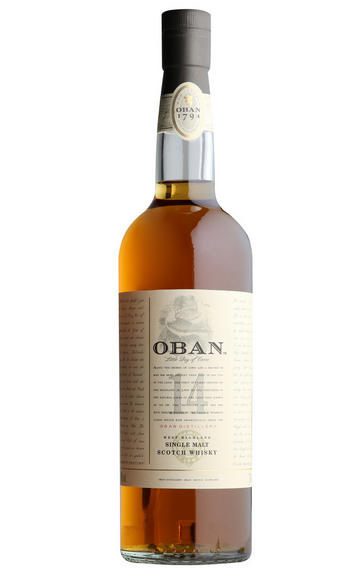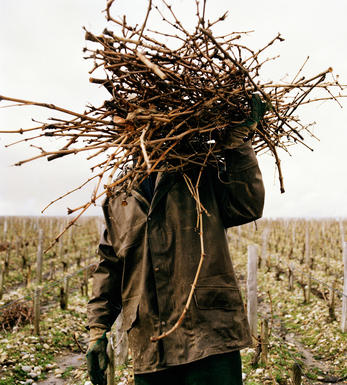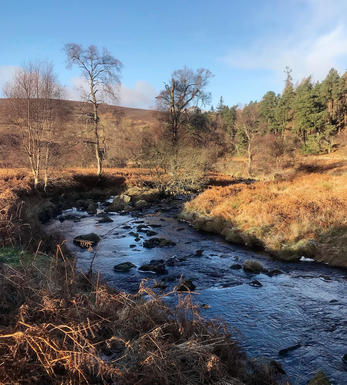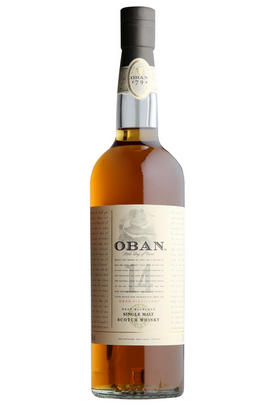
Critics reviews
Refreshing and gentle. Summer fruit. Melon. Vanilla pod. Touch of new leather. Developing on cooked fruit notes. Pear pie. Stewed peaches. Yeasty.
Palate
Delivers nose promises. Smooth and silky.
Finish
Fruity, gentle and slightly nutty.
Comment
Classic, gentle and pleasing. A consensual malt. Good match with salmon and light seafood dishes.
Martine Nouet - Whisky Magazine Issue 45 Nose
Spicy. Hot sawdust, fresh ginger, citrus zest. Crisp. With water fragrant oak, allspice, shortbread with sugar. Summery.
Palate
Dried apricot, tingling. Slightly sweet with good balance in the mid-palate. Hint of menthol.
Finish
Tingling ginger. Short but fresh.
Comment
Good energy, balance with surprising weight.
Dave Broom - Whisky Magazine Issue 45
About this SPIRIT

Oban Distillery, Highlands
Oban distillery is one of the oldest in Scotland. Nestled in the very heart of the charming harbour town of Oban, it is the gateway and the last frontier between the West Highlands and the Islands, most notably the Isle of Mull nearby.
Its history stretches back to 1794, when it was errected by the Stevenson brothers, Hugh, John and James, also founders of the city of Oban. In 1883 J. Walter Higgin bought the distillery. Between 1890 and 1894 he dismantled and rebuilt it bit by bit, in order to keep it in production - such was the demand for Oban's malt. In contrast to many other distilleries created at that time, Oban has been produced as a single malt since the 1880's.
Higgin carefully replicated the small stills and other traditional features in order to preserve the quality of the whisky. During the refurbishment in the 1890's, a remnant of Oban Bay's ancient beginnings was revealed when a cave containing Mesolithic human remains dating 4500 years BC was discovered behind the distillery (now on exhibition in the National Museum of Antiquities in Edinburgh). The Dewar's group became the owners in 1923 and it is nowadays part of the Diageo drinks group.
The standard Oban style is a 14 year old malt which is rich and full-bodied with a mellow fruity finish and very light peat nuances. It essentially combines West Highland and Island malt styles, reflecting its geographical position between the two, as well as its temperate, rainy climate.

Highlands Whisky
Maybe because it is the largest geographical area, the Highlands is also the hardest Whisky region to pin down stylistically. For this reason it is easiest not to consider the Highlands as one large are, but as 4 smaller and much more distinct ones.
North-Highland malts tend to be light bodied, delicate whiskies with complex aromas and a dryish finish sometimes spicy, sometimes with a trace of salt. Northern Highland distilleries are almost all coastal. The most northerly is Old Pulteney, situated about as far north as you can go in Wick, which produces a delicious, fragrant, dry whisky.
Working south along the route of the A9, next comes Clynelish at Brora (built in 1969, beside an earlier distillery who’s whiskies are known as Brora) - a sophisticated and complex whisky older expressions are very highly regarded and the malt deserves to be better known. Perhaps the reason that it is rarely seen as a distillery bottling is that it’s malt is a key component of Johnnie Walker.
The best known of all the Northern Highland malts is Glenmorangie. Glenmorangie, is made at Tain on the Cromarty Firth, and is the most popular malt in Scotland. Over the last decade Glenmorangie pioneered the now often copied process of wood finishing. Althoght this process is not universally popular; it transformed the company’s commercial success.
The Eastern Highlands produce a number of whiskies that can be confused with those of Speyside. In the north of the region close to the southern border of Speyside, whiskies which are smooth, sometimes with a little smoke, malty-sweet, such as Macduff, Ardmore, Glen Garioch and Knockdhu are made.
Further south is Fettercairn, and Glencadam, at Brechin, which produces an unusual creamy, fruity malt. The area between the Moray and the Tay has two distilleries of note; Royal Lochnagar and Glendronach. The first is a wonderfully smooth, rich whisky made in the shadow of the mountain of the same name in a distillery established in 1825 The second is also luscious and often sherried.
In the Western Highlands there only two distilleries on the mainland those of Oban and Ben Nevis. Oban is a perfect, sheltered harbour makes it the principal seaport for the Isles and the capital of the West Highlands. Its whisky has a misty, briny character, with a background of heather and peat.
The Oban whisky stills used are among the smallest in Scotland; the cramped nature of the site is attested to by the odd position of the worm tubs, fed by unusually short lyne arms, and nestled in the ‘vee’ between the roofs of the still house and an adjoining building.
The whiskies of the Central Highlands are a mixed bag. Generally they are lighter-bodied and sweeter that their cousins to the east, but not as sweet as Speysides.
The Central Highland single malts used to be known as 'Perthshire Whiskies'. Most are found along the valleys of the Tay and its tributaries. The furthest north is Dalwhinnie, which is almost in Speyside indeed; it is at the very head of the river, over sixty miles from Grantown-on-Spey.
Blair Athol and Edradour whisky distilleries are both near Pitlochrie. The former was founded in the 1790s and was substantially rebuilt in 1949 Edradour is the smallest distillery in Scotland - a happy survivor of the days of 'farm distilleries' - yet produces a clean, fresh, attractive and justly popular whisky.
South again is Aberfeldy distillery, on the edge of the pretty town of the same name. Glenturret, at Crieff is one of the claimants to being the oldest distillery, although it was dismantled in the 1920s and is much changed.



Buying options
Add to wishlist
Description
Oban is the gateway to the isles and the only town to have its distillery on the High Street. The whisky shares a little of the highland and a little of the island style, there is a definite salty accent, delicate fruitiness and a good dry smoky finish.
spirit at a glance
Delivery and quality guarantee